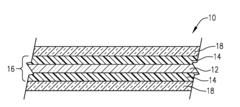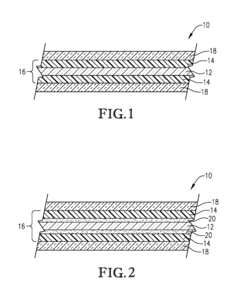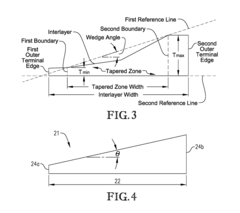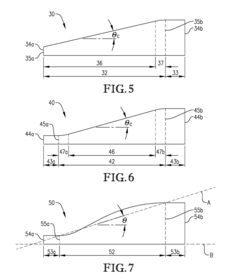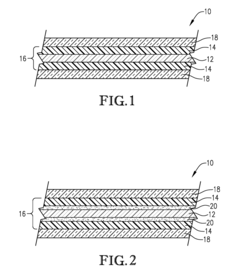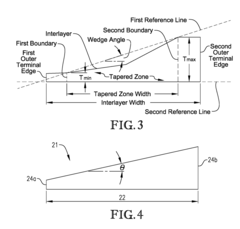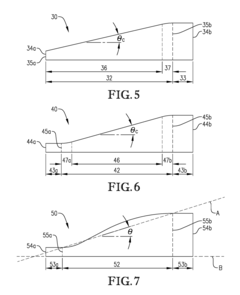Innovations in Multi-Layered Cellophane Structures
JUL 9, 20259 MIN READ
Generate Your Research Report Instantly with AI Agent
Patsnap Eureka helps you evaluate technical feasibility & market potential.
Cellophane Evolution
Cellophane, a transparent film made from regenerated cellulose, has undergone significant evolution since its invention in the early 20th century. The journey of cellophane began in 1900 when Swiss chemist Jacques E. Brandenberger conceived the idea of creating a clear, protective coating for tablecloths. His initial attempts resulted in a thin, flexible sheet that peeled off easily – the precursor to modern cellophane.
By 1908, Brandenberger had perfected his invention and patented the first machine for manufacturing cellophane. This marked the beginning of cellophane's commercial production. The early cellophane was primarily used for packaging luxury items and as a moisture-proof wrapping for various products.
The 1920s saw a major breakthrough in cellophane technology when DuPont acquired the rights to produce cellophane in the United States. DuPont's research team, led by William Hale Charch, developed a moisture-proof coating for cellophane in 1927. This innovation dramatically expanded cellophane's applications, particularly in the food packaging industry.
Throughout the mid-20th century, cellophane continued to evolve with improvements in production processes and the development of new coatings. These advancements enhanced cellophane's barrier properties, making it more resistant to moisture, gases, and odors. The introduction of heat-sealable cellophane in the 1940s further revolutionized packaging techniques.
The late 20th century saw the emergence of multi-layered cellophane structures. This innovation combined the benefits of cellophane with other materials, creating composite films with superior properties. These multi-layered structures offered improved barrier characteristics, enhanced mechanical strength, and better printability.
In recent years, the focus of cellophane evolution has shifted towards sustainability and environmental concerns. Researchers have been working on developing bio-based and biodegradable cellophane alternatives to address the growing demand for eco-friendly packaging solutions. This has led to the exploration of new cellulose sources and the optimization of production processes to reduce environmental impact.
The latest innovations in multi-layered cellophane structures have centered on creating ultra-thin, high-performance films. These advanced structures incorporate nanomaterials and specialized coatings to achieve exceptional barrier properties while maintaining transparency and flexibility. Such developments have opened up new possibilities for cellophane in high-tech applications, including electronics and medical devices.
As we move into the 21st century, the evolution of cellophane continues to be driven by the need for more sustainable, functional, and versatile packaging materials. The ongoing research in nanotechnology, biopolymers, and smart materials is expected to further transform cellophane, potentially leading to the development of active and intelligent packaging solutions that can interact with their contents and environment.
By 1908, Brandenberger had perfected his invention and patented the first machine for manufacturing cellophane. This marked the beginning of cellophane's commercial production. The early cellophane was primarily used for packaging luxury items and as a moisture-proof wrapping for various products.
The 1920s saw a major breakthrough in cellophane technology when DuPont acquired the rights to produce cellophane in the United States. DuPont's research team, led by William Hale Charch, developed a moisture-proof coating for cellophane in 1927. This innovation dramatically expanded cellophane's applications, particularly in the food packaging industry.
Throughout the mid-20th century, cellophane continued to evolve with improvements in production processes and the development of new coatings. These advancements enhanced cellophane's barrier properties, making it more resistant to moisture, gases, and odors. The introduction of heat-sealable cellophane in the 1940s further revolutionized packaging techniques.
The late 20th century saw the emergence of multi-layered cellophane structures. This innovation combined the benefits of cellophane with other materials, creating composite films with superior properties. These multi-layered structures offered improved barrier characteristics, enhanced mechanical strength, and better printability.
In recent years, the focus of cellophane evolution has shifted towards sustainability and environmental concerns. Researchers have been working on developing bio-based and biodegradable cellophane alternatives to address the growing demand for eco-friendly packaging solutions. This has led to the exploration of new cellulose sources and the optimization of production processes to reduce environmental impact.
The latest innovations in multi-layered cellophane structures have centered on creating ultra-thin, high-performance films. These advanced structures incorporate nanomaterials and specialized coatings to achieve exceptional barrier properties while maintaining transparency and flexibility. Such developments have opened up new possibilities for cellophane in high-tech applications, including electronics and medical devices.
As we move into the 21st century, the evolution of cellophane continues to be driven by the need for more sustainable, functional, and versatile packaging materials. The ongoing research in nanotechnology, biopolymers, and smart materials is expected to further transform cellophane, potentially leading to the development of active and intelligent packaging solutions that can interact with their contents and environment.
Market Applications
Multi-layered cellophane structures have found widespread applications across various industries, revolutionizing packaging, manufacturing, and consumer goods sectors. In the food industry, these innovative structures have significantly enhanced food preservation capabilities. The multiple layers provide superior barrier properties against moisture, oxygen, and other environmental factors, extending the shelf life of perishable goods. This technology has been particularly impactful in reducing food waste and improving the quality of packaged foods during transportation and storage.
The pharmaceutical sector has also embraced multi-layered cellophane structures for drug packaging. These materials offer excellent protection against light, moisture, and contaminants, ensuring the stability and efficacy of sensitive medications. The ability to incorporate different functional layers has enabled the development of smart packaging solutions that can indicate temperature breaches or tampering, enhancing drug safety and compliance.
In the electronics industry, multi-layered cellophane structures have found applications in flexible displays and electronic components. The combination of transparency, flexibility, and barrier properties makes these materials ideal for creating thin, lightweight, and durable electronic devices. This has contributed to the advancement of wearable technology and flexible electronics, opening new possibilities for product design and functionality.
The automotive sector has incorporated multi-layered cellophane structures in various applications, including interior components and safety features. These materials offer lightweight alternatives to traditional plastics, contributing to overall vehicle weight reduction and improved fuel efficiency. Additionally, their barrier properties have been utilized in fuel system components to prevent permeation and emissions.
The construction industry has also benefited from innovations in multi-layered cellophane structures. These materials have been integrated into building insulation systems, providing excellent thermal and moisture barriers while maintaining a thin profile. This has led to improved energy efficiency in buildings and expanded design possibilities for architects.
In the textile industry, multi-layered cellophane structures have been used to create high-performance fabrics with enhanced moisture management and breathability. These materials have found applications in sportswear, outdoor gear, and protective clothing, offering improved comfort and functionality to end-users.
The versatility of multi-layered cellophane structures has also led to their adoption in the cosmetics and personal care industry. These materials are used in packaging solutions that offer better protection for sensitive formulations while providing an attractive and sustainable alternative to traditional plastic packaging.
The pharmaceutical sector has also embraced multi-layered cellophane structures for drug packaging. These materials offer excellent protection against light, moisture, and contaminants, ensuring the stability and efficacy of sensitive medications. The ability to incorporate different functional layers has enabled the development of smart packaging solutions that can indicate temperature breaches or tampering, enhancing drug safety and compliance.
In the electronics industry, multi-layered cellophane structures have found applications in flexible displays and electronic components. The combination of transparency, flexibility, and barrier properties makes these materials ideal for creating thin, lightweight, and durable electronic devices. This has contributed to the advancement of wearable technology and flexible electronics, opening new possibilities for product design and functionality.
The automotive sector has incorporated multi-layered cellophane structures in various applications, including interior components and safety features. These materials offer lightweight alternatives to traditional plastics, contributing to overall vehicle weight reduction and improved fuel efficiency. Additionally, their barrier properties have been utilized in fuel system components to prevent permeation and emissions.
The construction industry has also benefited from innovations in multi-layered cellophane structures. These materials have been integrated into building insulation systems, providing excellent thermal and moisture barriers while maintaining a thin profile. This has led to improved energy efficiency in buildings and expanded design possibilities for architects.
In the textile industry, multi-layered cellophane structures have been used to create high-performance fabrics with enhanced moisture management and breathability. These materials have found applications in sportswear, outdoor gear, and protective clothing, offering improved comfort and functionality to end-users.
The versatility of multi-layered cellophane structures has also led to their adoption in the cosmetics and personal care industry. These materials are used in packaging solutions that offer better protection for sensitive formulations while providing an attractive and sustainable alternative to traditional plastic packaging.
Technical Challenges
The development of multi-layered cellophane structures faces several significant technical challenges that hinder widespread adoption and innovation in this field. One of the primary obstacles is achieving optimal adhesion between different layers of cellophane without compromising the material's transparency or flexibility. The interface between layers often becomes a weak point, leading to delamination or reduced overall strength of the structure.
Another major challenge lies in maintaining the desired barrier properties across multiple layers. While cellophane itself offers good moisture resistance, creating a multi-layered structure that effectively blocks gases, aromas, and UV light while retaining the benefits of each individual layer remains complex. Balancing these properties often requires trade-offs that can impact the overall performance of the material.
The manufacturing process for multi-layered cellophane structures presents its own set of difficulties. Ensuring uniform thickness and consistent bonding across large surface areas during production is technically demanding. Additionally, the high temperatures often required for lamination can cause warping or degradation of the cellophane, affecting the final product quality.
Recyclability and environmental concerns pose significant challenges in the development of multi-layered cellophane structures. The combination of different materials in these structures often makes them difficult to recycle, conflicting with growing demands for sustainable packaging solutions. Developing eco-friendly adhesives and separation techniques for recycling remains an ongoing challenge for researchers and manufacturers.
Scalability and cost-effectiveness are also major hurdles in the widespread adoption of innovative multi-layered cellophane structures. While laboratory-scale production may yield promising results, translating these innovations to industrial-scale manufacturing while maintaining quality and keeping costs competitive is a significant challenge. The need for specialized equipment and processes often increases production costs, making it difficult for new technologies to compete with established packaging solutions.
Lastly, regulatory compliance and safety standards present ongoing challenges for innovations in this field. As new multi-layered structures are developed, they must undergo rigorous testing to ensure they meet food safety regulations, especially for applications in food packaging. This process can be time-consuming and costly, potentially slowing down the pace of innovation and market entry for new products.
Another major challenge lies in maintaining the desired barrier properties across multiple layers. While cellophane itself offers good moisture resistance, creating a multi-layered structure that effectively blocks gases, aromas, and UV light while retaining the benefits of each individual layer remains complex. Balancing these properties often requires trade-offs that can impact the overall performance of the material.
The manufacturing process for multi-layered cellophane structures presents its own set of difficulties. Ensuring uniform thickness and consistent bonding across large surface areas during production is technically demanding. Additionally, the high temperatures often required for lamination can cause warping or degradation of the cellophane, affecting the final product quality.
Recyclability and environmental concerns pose significant challenges in the development of multi-layered cellophane structures. The combination of different materials in these structures often makes them difficult to recycle, conflicting with growing demands for sustainable packaging solutions. Developing eco-friendly adhesives and separation techniques for recycling remains an ongoing challenge for researchers and manufacturers.
Scalability and cost-effectiveness are also major hurdles in the widespread adoption of innovative multi-layered cellophane structures. While laboratory-scale production may yield promising results, translating these innovations to industrial-scale manufacturing while maintaining quality and keeping costs competitive is a significant challenge. The need for specialized equipment and processes often increases production costs, making it difficult for new technologies to compete with established packaging solutions.
Lastly, regulatory compliance and safety standards present ongoing challenges for innovations in this field. As new multi-layered structures are developed, they must undergo rigorous testing to ensure they meet food safety regulations, especially for applications in food packaging. This process can be time-consuming and costly, potentially slowing down the pace of innovation and market entry for new products.
Current Solutions
01 Multi-layered cellophane structures for packaging
Multi-layered cellophane structures are used in packaging applications to provide improved barrier properties, strength, and flexibility. These structures can consist of multiple layers of cellophane or combinations of cellophane with other materials to enhance performance characteristics such as moisture resistance, gas permeability, and durability.- Multi-layered cellophane structures for packaging: Multi-layered cellophane structures are used in packaging applications to provide improved barrier properties, strength, and flexibility. These structures can be designed with different layers of cellophane or combined with other materials to enhance specific properties such as moisture resistance or heat sealability.
- Optical applications of multi-layered cellophane: Multi-layered cellophane structures are utilized in optical applications, such as displays, filters, and light-guiding devices. The layered structure allows for manipulation of light transmission, reflection, and polarization properties, making it suitable for various optical components and systems.
- Electronic and semiconductor applications: Multi-layered cellophane structures find applications in electronic and semiconductor devices. They can be used as substrates, insulating layers, or protective coatings in various electronic components, offering advantages such as flexibility, transparency, and dielectric properties.
- Energy storage and conversion devices: Multi-layered cellophane structures are employed in energy storage and conversion devices, such as batteries and fuel cells. The layered structure can be designed to enhance ion conductivity, separate electrodes, or provide a barrier against electrolyte leakage, improving the overall performance and safety of these devices.
- Manufacturing processes for multi-layered cellophane structures: Various manufacturing processes are used to produce multi-layered cellophane structures, including extrusion, lamination, and coating techniques. These processes allow for precise control of layer thickness, composition, and properties, enabling the creation of tailored structures for specific applications.
02 Optical applications of multi-layered cellophane
Multi-layered cellophane structures are utilized in optical applications, such as display devices, optical filters, and light management systems. The layered structure allows for manipulation of light transmission, reflection, and polarization properties, making them suitable for various optical components and devices.Expand Specific Solutions03 Electronic and semiconductor applications
Multi-layered cellophane structures find applications in electronic and semiconductor industries. They can be used as substrates, insulating layers, or protective coatings in electronic components, flexible circuits, and semiconductor devices. The layered structure provides electrical insulation and mechanical protection.Expand Specific Solutions04 Energy storage and conversion devices
Multi-layered cellophane structures are employed in energy storage and conversion devices such as batteries, capacitors, and fuel cells. The layered configuration allows for improved ion transport, electrode separation, and overall device performance. These structures can enhance energy density and cycling stability in energy storage applications.Expand Specific Solutions05 Manufacturing processes for multi-layered cellophane structures
Various manufacturing processes are used to produce multi-layered cellophane structures, including lamination, coating, and extrusion techniques. These processes allow for precise control of layer thickness, composition, and properties. Advanced manufacturing methods enable the creation of complex multi-layered structures with tailored functionalities for specific applications.Expand Specific Solutions
Industry Leaders
The market for innovations in multi-layered cellophane structures is in a growth phase, driven by increasing demand for advanced packaging solutions across various industries. The global market size for specialty films, including multi-layered cellophane, is projected to reach significant value in the coming years. Technologically, the field is advancing rapidly, with companies like Eastman Chemical, Solutia, and Arkema leading in research and development. These firms are focusing on enhancing barrier properties, improving sustainability, and developing novel applications. Emerging players such as AGC and Nippon Sheet Glass are also making strides in this space, particularly in Asia. The competitive landscape is characterized by a mix of established chemical giants and specialized materials companies, all vying for market share through innovation and strategic partnerships.
Eastman Chemical Co.
Technical Solution: Eastman Chemical Co. has developed innovative multi-layered cellophane structures using their proprietary Tritan™ copolyester technology. This approach involves creating multiple layers of cellophane with varying compositions to enhance overall performance. The company has implemented a novel extrusion process that allows for precise control of layer thickness and composition[1]. Their multi-layered cellophane structures incorporate additives such as nanoparticles and specialty polymers to improve barrier properties, mechanical strength, and thermal stability[2]. Eastman's technology also focuses on improving the biodegradability of the cellophane structures while maintaining high performance, addressing growing environmental concerns[3].
Strengths: Enhanced barrier properties, improved mechanical strength, and better thermal stability. Weaknesses: Potentially higher production costs and complexity in manufacturing process.
Dow Global Technologies LLC
Technical Solution: Dow Global Technologies has developed a multi-layered cellophane structure using their ELITE™ Enhanced Polyethylene Resins. This innovation involves creating alternating layers of different polyethylene grades to optimize both barrier properties and mechanical strength. The company utilizes a co-extrusion process that allows for the precise control of individual layer thicknesses, typically ranging from 5 to 50 microns[4]. Dow's technology incorporates specialized tie layers to ensure strong adhesion between the different cellophane layers, enhancing overall structural integrity[5]. Additionally, they have developed a proprietary surface treatment process to improve the printability and sealability of the outermost layers[6].
Strengths: Excellent barrier properties, high mechanical strength, and improved printability. Weaknesses: May have limitations in high-temperature applications compared to some competing technologies.
Key Innovations
Cellulose ester multilayer interlayers
PatentActiveUS20170259537A1
Innovation
- A multilayer interlayer comprising a non-cellulose ester layer and a cellulose ester layer with a hydroxyl content of at least 0.5 weight percent and a glass transition temperature of at least 50°C, which provides enhanced structural support and maintains desirable optical properties.
Cellulose ester multilayer interlayers
PatentActiveUS20170259540A1
Innovation
- A multilayer interlayer comprising a non-cellulose ester layer, specifically a thermoplastic polyurethane resin, combined with a cellulose ester layer having a hydroxyl content of at least 0.5 weight percent and a glass transition temperature of at least 50°C, which enhances structural support while maintaining optical clarity.
Environmental Impact
The environmental impact of multi-layered cellophane structures is a critical consideration in the development and adoption of this innovative packaging technology. These structures offer potential benefits in terms of resource efficiency and waste reduction, but also present challenges related to recycling and end-of-life management.
One of the primary environmental advantages of multi-layered cellophane structures is their ability to enhance product shelf life. By providing superior barrier properties against moisture, oxygen, and other environmental factors, these structures can significantly reduce food waste. This reduction in spoilage translates to more efficient use of agricultural resources and lower greenhouse gas emissions associated with food production and disposal.
Furthermore, the lightweight nature of multi-layered cellophane structures contributes to reduced transportation-related emissions. As these materials are typically thinner and lighter than traditional packaging alternatives, they require less fuel for shipping, thereby decreasing the carbon footprint of product distribution.
However, the complex composition of multi-layered cellophane structures poses recycling challenges. The combination of different materials in these structures often makes them difficult to separate and process through conventional recycling streams. This limitation can lead to increased landfill waste or incineration, both of which have negative environmental consequences.
To address these recycling issues, research is ongoing to develop more environmentally friendly multi-layered cellophane structures. Innovations in this area include the use of bio-based and biodegradable materials, as well as the design of structures that can be more easily separated for recycling. Some companies are exploring the potential of mono-material designs that maintain the desired barrier properties while improving recyclability.
The production process of multi-layered cellophane structures also warrants environmental scrutiny. While cellophane itself is derived from renewable resources, the additional layers and treatments applied to create multi-layered structures may involve petroleum-based materials and energy-intensive processes. Efforts are being made to optimize production methods and incorporate more sustainable materials to mitigate these impacts.
In conclusion, the environmental impact of multi-layered cellophane structures is multifaceted. While they offer benefits in terms of food preservation and transportation efficiency, challenges remain in recycling and end-of-life management. Ongoing research and innovation in this field aim to address these challenges and improve the overall sustainability of multi-layered cellophane packaging solutions.
One of the primary environmental advantages of multi-layered cellophane structures is their ability to enhance product shelf life. By providing superior barrier properties against moisture, oxygen, and other environmental factors, these structures can significantly reduce food waste. This reduction in spoilage translates to more efficient use of agricultural resources and lower greenhouse gas emissions associated with food production and disposal.
Furthermore, the lightweight nature of multi-layered cellophane structures contributes to reduced transportation-related emissions. As these materials are typically thinner and lighter than traditional packaging alternatives, they require less fuel for shipping, thereby decreasing the carbon footprint of product distribution.
However, the complex composition of multi-layered cellophane structures poses recycling challenges. The combination of different materials in these structures often makes them difficult to separate and process through conventional recycling streams. This limitation can lead to increased landfill waste or incineration, both of which have negative environmental consequences.
To address these recycling issues, research is ongoing to develop more environmentally friendly multi-layered cellophane structures. Innovations in this area include the use of bio-based and biodegradable materials, as well as the design of structures that can be more easily separated for recycling. Some companies are exploring the potential of mono-material designs that maintain the desired barrier properties while improving recyclability.
The production process of multi-layered cellophane structures also warrants environmental scrutiny. While cellophane itself is derived from renewable resources, the additional layers and treatments applied to create multi-layered structures may involve petroleum-based materials and energy-intensive processes. Efforts are being made to optimize production methods and incorporate more sustainable materials to mitigate these impacts.
In conclusion, the environmental impact of multi-layered cellophane structures is multifaceted. While they offer benefits in terms of food preservation and transportation efficiency, challenges remain in recycling and end-of-life management. Ongoing research and innovation in this field aim to address these challenges and improve the overall sustainability of multi-layered cellophane packaging solutions.
Regulatory Landscape
The regulatory landscape surrounding multi-layered cellophane structures is complex and evolving, reflecting the increasing focus on environmental sustainability and product safety. Governments and regulatory bodies worldwide are implementing stricter guidelines for packaging materials, particularly those used in food and consumer goods industries.
In the European Union, the European Food Safety Authority (EFSA) has established comprehensive regulations for food contact materials, including multi-layered cellophane structures. These regulations mandate rigorous testing and certification processes to ensure the safety of packaging materials that come into direct contact with food products. Manufacturers must demonstrate compliance with migration limits for various substances and provide detailed documentation on the composition and production processes of their cellophane structures.
The United States Food and Drug Administration (FDA) has also implemented stringent regulations for food packaging materials, including cellophane-based products. The FDA's Food Contact Substance Notification Program requires manufacturers to submit detailed information on the chemical composition and intended use of new packaging materials before they can be introduced to the market.
In Asia, countries like Japan and South Korea have established their own regulatory frameworks for food packaging materials, often aligning with international standards while addressing specific local concerns. These regulations typically focus on ensuring the safety of packaging materials and minimizing potential health risks to consumers.
Environmental regulations are increasingly impacting the development and use of multi-layered cellophane structures. Many countries have introduced or are considering legislation to reduce single-use plastics and promote recyclable or biodegradable packaging materials. This regulatory trend is driving innovation in the cellophane industry, pushing manufacturers to develop more environmentally friendly alternatives that maintain the desired functional properties.
The global nature of supply chains in the packaging industry necessitates compliance with multiple regulatory frameworks. This complexity has led to the emergence of international standards and certification bodies that aim to harmonize regulations across different regions. Organizations such as the International Organization for Standardization (ISO) play a crucial role in developing global standards for packaging materials, including those related to multi-layered cellophane structures.
As sustainability concerns continue to grow, regulatory bodies are likely to introduce more stringent requirements for the recyclability and biodegradability of packaging materials. This evolving regulatory landscape presents both challenges and opportunities for innovators in the multi-layered cellophane industry, driving the development of new materials and production processes that meet increasingly demanding environmental and safety standards.
In the European Union, the European Food Safety Authority (EFSA) has established comprehensive regulations for food contact materials, including multi-layered cellophane structures. These regulations mandate rigorous testing and certification processes to ensure the safety of packaging materials that come into direct contact with food products. Manufacturers must demonstrate compliance with migration limits for various substances and provide detailed documentation on the composition and production processes of their cellophane structures.
The United States Food and Drug Administration (FDA) has also implemented stringent regulations for food packaging materials, including cellophane-based products. The FDA's Food Contact Substance Notification Program requires manufacturers to submit detailed information on the chemical composition and intended use of new packaging materials before they can be introduced to the market.
In Asia, countries like Japan and South Korea have established their own regulatory frameworks for food packaging materials, often aligning with international standards while addressing specific local concerns. These regulations typically focus on ensuring the safety of packaging materials and minimizing potential health risks to consumers.
Environmental regulations are increasingly impacting the development and use of multi-layered cellophane structures. Many countries have introduced or are considering legislation to reduce single-use plastics and promote recyclable or biodegradable packaging materials. This regulatory trend is driving innovation in the cellophane industry, pushing manufacturers to develop more environmentally friendly alternatives that maintain the desired functional properties.
The global nature of supply chains in the packaging industry necessitates compliance with multiple regulatory frameworks. This complexity has led to the emergence of international standards and certification bodies that aim to harmonize regulations across different regions. Organizations such as the International Organization for Standardization (ISO) play a crucial role in developing global standards for packaging materials, including those related to multi-layered cellophane structures.
As sustainability concerns continue to grow, regulatory bodies are likely to introduce more stringent requirements for the recyclability and biodegradability of packaging materials. This evolving regulatory landscape presents both challenges and opportunities for innovators in the multi-layered cellophane industry, driving the development of new materials and production processes that meet increasingly demanding environmental and safety standards.
Unlock deeper insights with Patsnap Eureka Quick Research — get a full tech report to explore trends and direct your research. Try now!
Generate Your Research Report Instantly with AI Agent
Supercharge your innovation with Patsnap Eureka AI Agent Platform!
